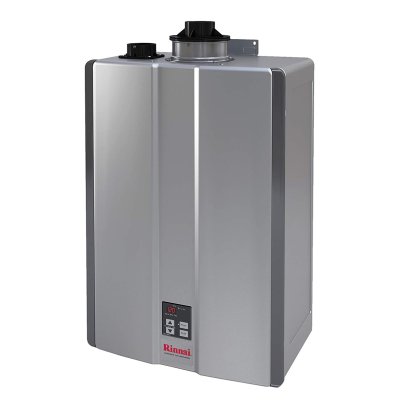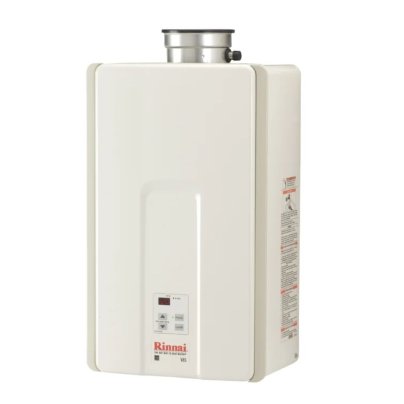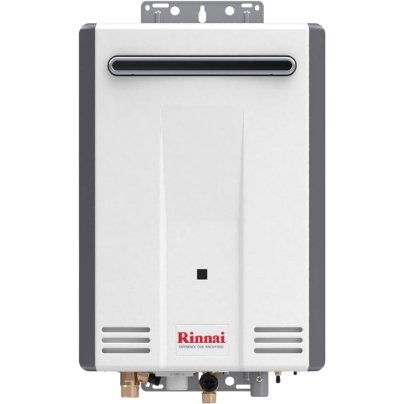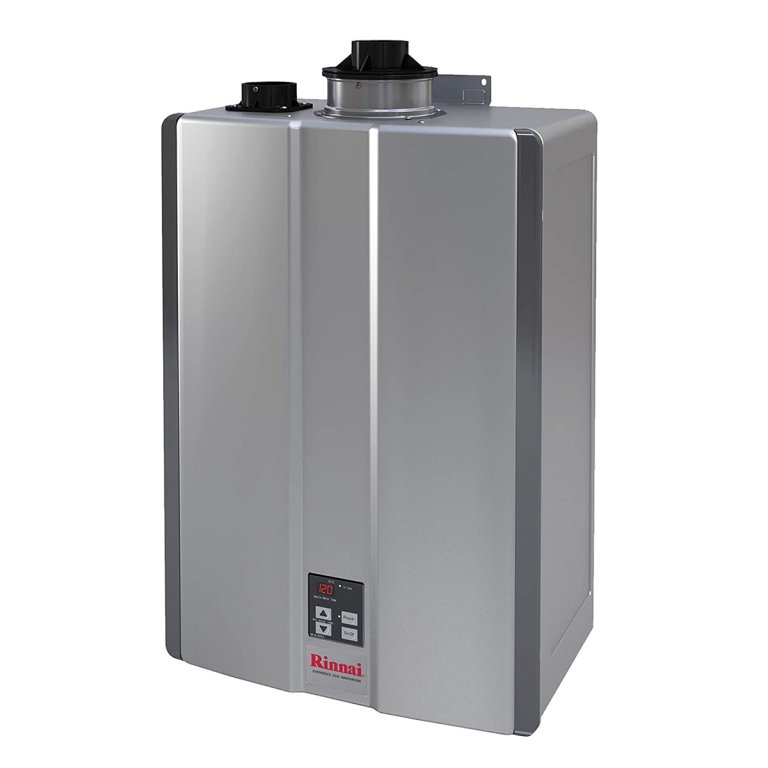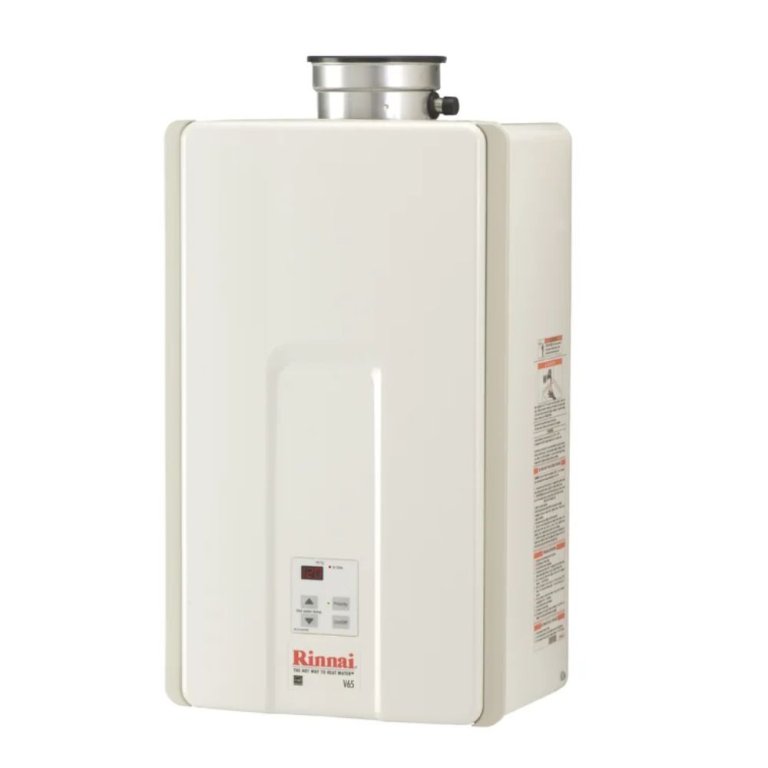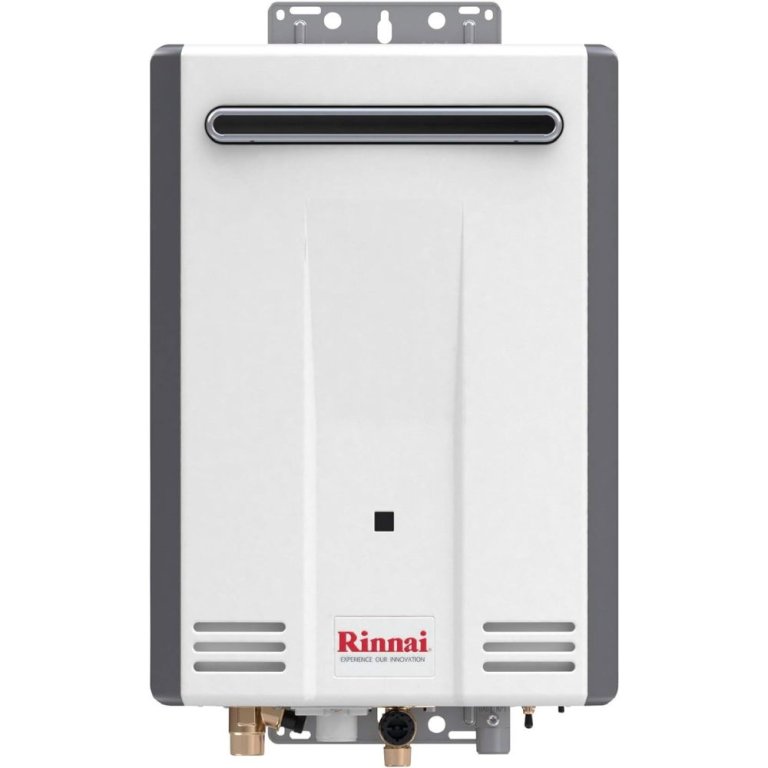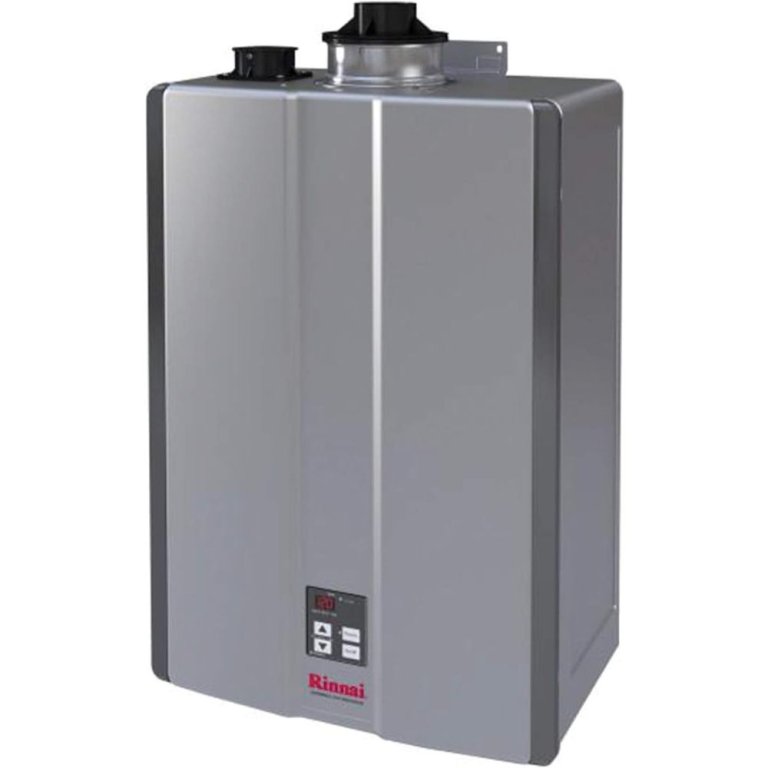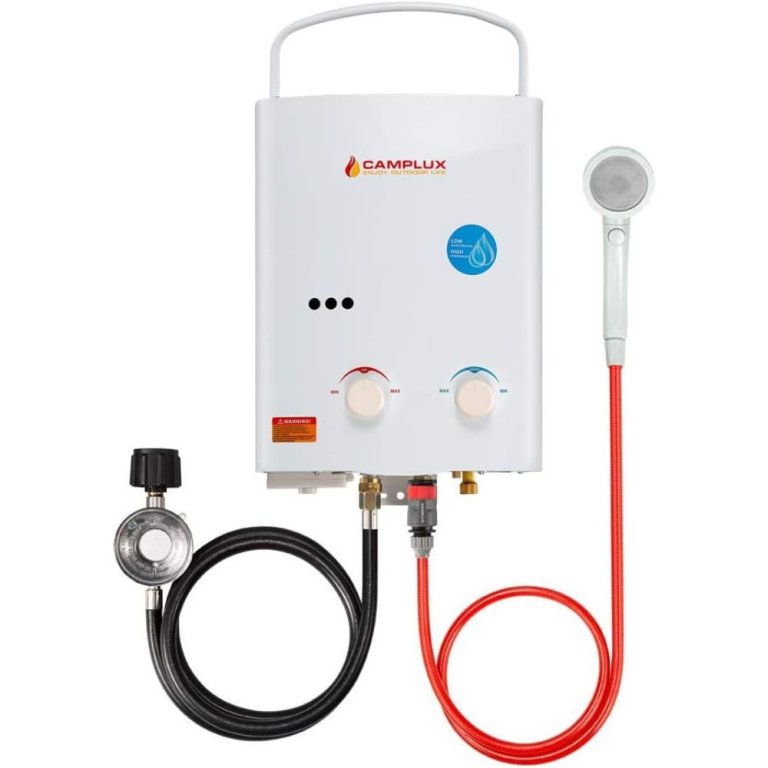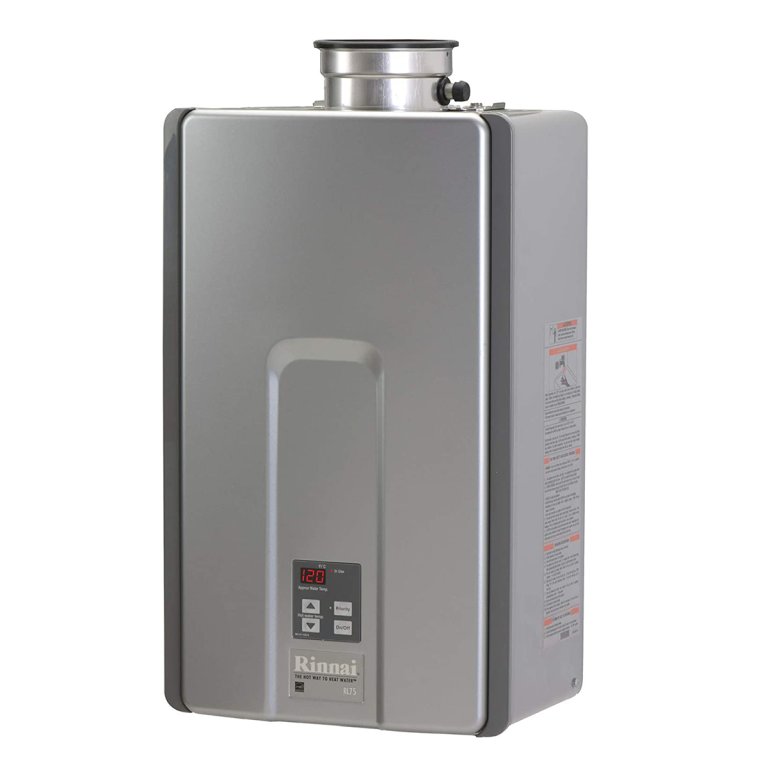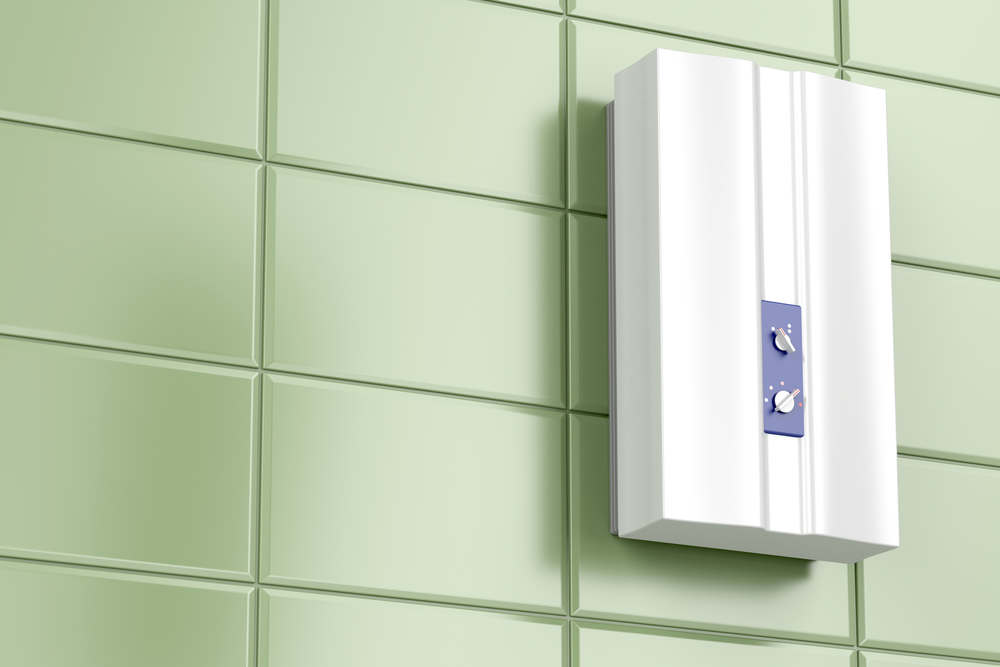
We may earn revenue from the products available on this page and participate in affiliate programs. Learn More ›
Traditional water heaters can be huge energy guzzlers because of the large storage tank of piping hot water they must maintain at all times. No wonder tankless or “on demand” water heaters were developed since they only heat water as you use it, making them more energy-efficient, and as an additional virtue, they take up far less space than conventional water heaters—a major plus in homes where floor space is at a premium.
The best tankless gas water heater is one that will lower utility costs while providing ample hot water for your family’s needs. Keep reading to learn which features to look for in a tankless gas water heater and to find out why the following six are our top picks for most homeowners.
- BEST OVERALL: Rinnai RU199iN High-Efficiency Tankless Water Heater
- RUNNER-UP: Rinnai V65iN High-Efficiency Tankless Water Heater
- BEST BANG FOR THE BUCK: Rinnai V53DeP High-Efficiency Tankless Water Heater
- UPGRADE PICK: Rinnai RU180iN High-Efficiency Tankless Water Heater
- BEST PORTABLE: Camplux 5L 1.32 GPM Tankless Water Heater
- ALSO CONSIDER: Rinnai RL75iN High-Efficiency Tankless Water Heater
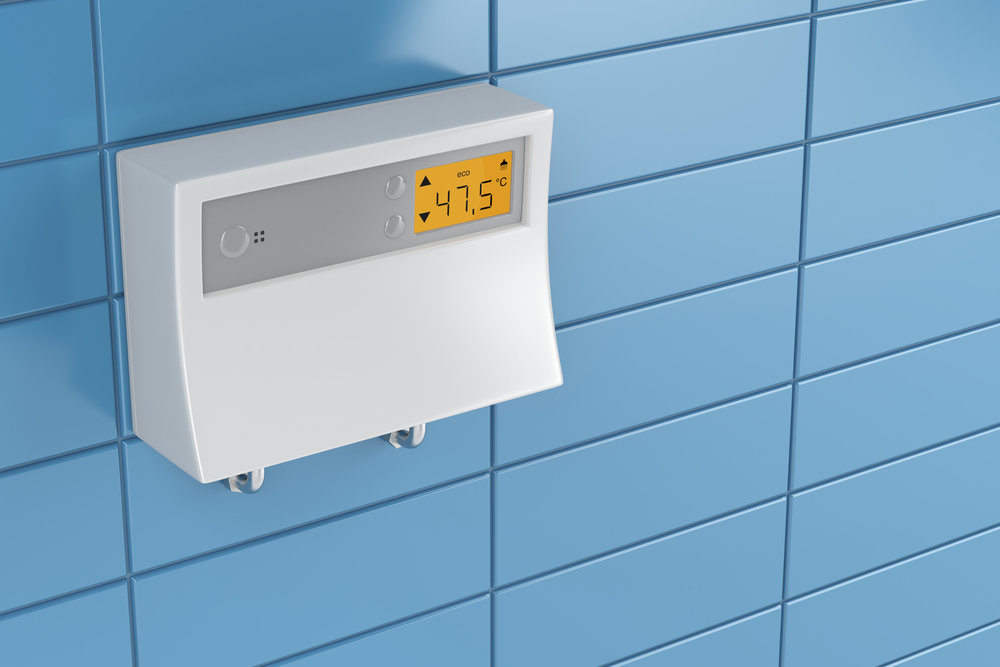
Before You Buy a Tankless Gas Water Heater
While a tankless gas water heater is a great option for many homeowners, if multiple family members use a lot of water at the same time—for example, two teens showering at the same time the dishwasher and clothes washer are running—a tankless water heater may have a tough time keeping up with the demand, resulting in a drop in water temperature.
Fortunately, there are large-capacity tankless water heaters that may help remedy inconsistent temperature issues, or you may choose to install two separate tankless units in different areas of the home. For example, one tankless gas water heater can be installed to heat water for a kitchen and laundry room, while a second can be installed to heat water for the bathrooms. Because tankless water heaters are generally smaller than an average suitcase, they can often easily be tucked into a laundry room or a utility closet.
In many areas, natural gas is less expensive than electricity, so opting for a tankless gas water heater is usually a good choice. The caveat is if the current water heater is electric, it’s usually simpler and more affordable to go with an electric tankless water heater. Switching from electric water heaters to gas models will incur additional installation expenses—up to thousands of dollars—for a licensed plumber to connect new gas supply lines and vents to exhaust the gas.
How We Chose the Best Tankless Gas Water Heaters
The best tankless gas water heaters are energy efficient and robust enough to pump out enough hot water for an entire household. Our list of recommendations gathers products that stand out from their competition in terms of reliability, energy-saving features, and flow rate. We made sure to offer a selection of the most reliable units on the market that have impressive flow rates and efficient gas consumption.
Our top tankless heaters also include some additional technology to help shoppers save extra on their utility bills while still being able to provide optimal levels of hot water. In our research, we looked at power input, venting options such as direct vent and power vent (as well as condensing and noncondensing units) to provide a list of our top recommendations suitable for a range of household sizes.
We even made sure to include a portable option for those who enjoy the great outdoors but perhaps still yearn for a hot shower.
Our Top Picks
The tankless gas water heaters reviewed below are high-quality, energy-efficient models that provide hot water on demand for years to come. Each of the options chosen has a thoroughly vetted list of pros and cons and is organized by category.
Best Overall
Rinnai RU199iN High-Efficiency Tankless Water Heater
Pros
- Supports average-size households with ease; can handle several hot water uses at the same time
- Circulation technology provides fast hot water and uses 40 percent less energy than traditional tanked options
- Wi-Fi monitoring allows the user to program circulating times and adjust as necessary
Cons
- High price point compared to similar options on the market
Product Specs
- Size: 31.3 inches high by 18.5 inches wide by 11.45 inches deep
- Power output: 199,00 British thermal units (BTUs)
- Flow rate: 11 gallons per minute (GPM)
For energy efficiency and the ability to produce enough hot water for an average household, it’s hard to beat the Rinnai RU199iN high-efficiency tankless water heater. This super-high-efficiency condensing unit recycles hot exhaust gases through its system to reduce energy waste and lower utility bills. It features a hearty 11 GPM of hot water flow and comes with 199,000 maximum BTU input capability so owners needn’t choose between running a load of laundry or taking a long, steamy shower. The RU199iN makes use of ThermaCirc360 technology that recirculates a bit of warm water through the home’s water lines to ensure that you won’t have to wait annoying minutes after turning on the faucet to have piping hot water.
The RU199iN also comes with Wi-Fi monitoring, so it can program the precirculation times (such as when owners get up in the morning) while also allowing them to check the unit’s efficiency from a tablet or smartphone. This unit is available in either a natural gas or propane model, both of which are 40 percent more efficient than tanked options on the market.
Get the Rinnai RU199iN tankless gas water heater at Amazon or The Home Depot.
Runner-Up
Rinnai V65iN High-Efficiency Tankless Water Heater
Pros
- WiFi-ready model allows the user to monitor and adjust the unit via smartphone or tablet
- Suitable for small- to medium-size homes with an output of 6.5 gallons per minute
- Energy-efficient design has a 0.82 energy factor rating; cuts back on the energy bill
- Compact unit is smaller than a suitcase; will not take up a lot of space in a utility closet or basement
Cons
- Unit requires new water and gas supply connections for proper installation
Product Specs
- Size: 26.9 inches high by 14.04 inches wide by 9.27 inches deep
- Power output: 150,000 BTUs
- Flow rate: 6.5 GPM
Designed to operate with efficiency while providing comfort, the Rinnai V65iN high-efficiency tankless water heater doesn’t disappoint. It features a 150,000 BTU maximum output and provides 6.5 GPM hot water outflow, making it a good option for a home with one or two bathrooms and one to two adults or teens. Like other Rinnai units, the V65iN can sync with Wi-Fi and smartphones or tablets and can be used with digital controllers (sold separately). This model also has a 0.82 energy factor rating, is 40 percent more efficient than traditional units with tanks, and its compact size won’t take up space in small basements or utility closets.
Get the Rinnai V65iN tankless gas water heater at The Home Depot or Wayfair.
Best Bang For The Buck
Rinnai V53DeP High-Efficiency Tankless Water Heater
Pros
- Provides hot water to small- to medium-size homes all through the year
- Compact construction withstands the elements without taking up too much space
- Lower price point compared to some other options on the market
Cons
- Designed for use outdoors; may not be ideal for some users’ preferences
- Professional installation is recommended to ensure proper operation
Product Specs
- Size: 21.8 inches high by 14 inches wide by 7.9 inches deep
- Power output: 120,000 BTUs
- Flow rate: 5.3 GPM
Those who are hoping to conserve energy without spending a lot on a gas tankless water heater will want to consider the noncondensing Rinnai V53DeP high-efficiency tankless water heater. This tankless propane water heater is designed for outdoor installation and will provide up to 5.3 GPM hot water flow, depending on the ground temperature (colder temperatures can reduce hot water flow).
This affordable water heater is well-suited to small homes in warm rural areas where temps remain above freezing all year and where natural gas is not piped into the home. It’s also suitable for seasonal vacation homes where it can be drained and shut down during cold months. It comes with a maximum BTU output of 120,000, so it will provide enough hot water for a small 1-bathroom home or a vacation cabin where showers are staggered.
Get the Rinnai V53DeP tankless gas water heater at Amazon or The Home Depot.
Upgrade Pick
Rinnai RU180iN High-Efficiency Tankless Water Heater
Pros
- Provides enough water for large homes; suitable for families of 4 and up
- Comes with a uniform energy factor of 0.95 and Energy Star certification
- Condensing feature seals in all the heat from the exhaust gas before hot water is distributed
- Compact and lightweight unit will not take up a lot of space
Cons
- The manufacturer recommends professional help during the installation process
Product Specs
- Size: 31.1 inches high by 18.5 inches wide by 11.54 inches deep
- Power output: 180,000 BTUs
- Flow rate: 10 GPM
Reliability meets user-friendliness in the Rinnai RU180iN tankless water heater. This heavy-duty model has a maximum output of 10 GPM, which can provide water to over five appliances at a time, all while having a power output of over 180,000 BTUs. This Rinnai is also equipped with an Energy Star certification and a uniform energy factor of 0.95, making it effective but also light on the energy bill. It also has a condensing feature that seals in as much heat as possible before releasing through the ventilation system. Finally, the Rinnai RU180iN indoor unit is the size of a small suitcase, so it won’t take up a lot of space.
What our tester says: Debbie Wolfe, Bob Vila editor and product tester, says about this tankless water heater: “When it came time to replace my old tank water heater, my plumber highly recommended Rinnai due to its reputation for quality. He determined the 180,000 BTU 10 GPM model best fit my family’s hot water needs. The appliance heats the water quickly and is easily adjustable via the straightforward display on the front of the machine. I especially like that it doesn’t take up floor space in my basement—it fits neatly on the wall. There is a slight delay in hot water delivery first thing in the morning, when the tank has not been used for hours. However, once it’s activated, the hot water is readily available for the rest of the day.” Get the Rinnai RU180iN tankless gas water heater at Amazon or The Home Depot.
Best Portable
Camplux 5L 1.32 GPM Tankless Water Heater
Pros
- Compact and portable unit can be hung on a tree or post wherever needed; weighs only 10 pounds
- Provides up to 3.0 pounds per square inch as soon as it is operational; setup is quick and easy
- Affordable unit compared to other options on the market
Cons
- Not suited for running an entire household
Product Specs
- Size: 20.28 inches high by 11.42 inches wide by 4.33 inches deep
- Power output: 34,000 BTUs
- Flow rate: 1.32 GPM
Enjoy hot water wherever you go—even if camping or off the grid—with the Camplux tankless water heater. This propane-powered water heater is designed to provide up to 1.32 GPM, supplying enough hot water to take a short shower or wash dishes. At just 34,000 BTUs, the Camplux won’t heat enough water to run a household, but it will be a welcome addition where no other source of hot water is to be found. The igniter on the water heater requires two D-cell batteries (or plug it into a standard outlet, when available). The Camplux can be paired with a 12-volt water pump to increase water pressure, and the 10-pound unit comes with a handle that can be hung over a hook or a strong tree limb.
Get the Camplux tankless gas water heater at Amazon, The Home Depot, or Walmart.
Best Overall
Rinnai RL75iN High-Efficiency Tankless Water Heater
Pros
- Wi-Fi connectivity for remote programming and monitoring via smartphone or tablet
- High-quality and reliable unit comes with ThermaCirc360 technology for instant access
- Ideal for 2-bathroom homes with its 7.5 GPM flow rate
Cons
- Installation not DIY-friendly; professional help should be used
Product Specs
- Size: 26.9 inches high by 14.04 inches wide by 9.27 inches deep
- Power output: 180,000 BTUs
- Flow rate: 7.5 GPM
Enjoy lower utility bills with the Rinnai RL75iN tankless water heater, which provides up to 7.5 GPM of hot water flow and comes with maximum 180,000 BTU input, making it well-suited to homes with two bathrooms and two to three adults or teens. This non-condensing, natural gas-powered tankless hot water heater comes with Rinnai’s ThermaCirc360 technology to ensure consistently hot water as soon as the faucet is turned on. The unit also syncs with WiFi and can be monitored and programmed remotely.
Get the Rinnai RL75iN tankless gas water heater at Amazon or The Home Depot.
Jump to Our Top Picks
What to Consider When Choosing a Tankless Gas Water Heater
While the concept is simple—heat water and distribute it to faucets and appliances—choosing the best tankless gas water heater requires an understanding of how they function. On average, depending on where you live, you could spend $2,000 to $6,500 to purchase and install a tankless gas water heater, so you’ll want to get the right one the first time around.
Propane vs. Natural Gas
For most homeowners, a natural gas tankless water heater is the best option because natural gas is often supplied by a utility company, via gas lines, directly into the home. Natural gas is typically more affordable than propane as well, although this can vary by region and local costs.
Propane, however, is often the only type of gas available to rural dwellers, campers, and those who live off-grid. If this applies to you, look for a tankless water heater that accommodates propane gas. Fortunately, many water heater manufacturers offer conversion kits that allow the user to convert a natural gas water heater to a propane water heater and vice versa.
Indoor vs. Outdoor Application
In most areas of the country where winter temperatures dip below freezing, it’s not advised to install an outdoor tankless water heater—cold temperatures will reduce its efficiency and could even freeze and damage the unit. That’s why most homeowners opt for an indoor tankless water heater. Yet there are some situations in which an outdoor model might make sense, like when you need hot water for a pool house or in a remote location, such as when camping.
Another exception includes homes where an interior tank-type electric water heater is being replaced by a tankless gas heater and there’s no way to install venting or bring in a gas line (if the home already has a gas water heater, this wouldn’t be an issue). In this limited situation, if an outdoor gas tankless water heater is desired, it should be insulated and protected, perhaps in an attached garage or shed to reduce the risk of damage and energy inefficiency from cold temperatures.
Flow Rate (GPM)
Sizing a tankless water heater correctly is an important step in the selection process because it will determine whether you’ll have sufficient hot water for all your needs. Tankless water heaters are rated by the number of gallons of hot water they produce per minute (GPM). To determine your family’s GPM needs, consider how many gallons per minute of hot water (on average) the following fixtures and appliances use.
- Bathroom or kitchen faucet: 0.5 GPM
- Shower: 2.5 GPM
- Dishwasher: 1.0 GPM
- Clothes washer: 1.5 GPM
Using the above examples as a general rule, consider which time of day your family uses the most hot water. For example, if two family members will be showering while the dishwasher is running, your tankless water heater would need to provide a minimum of 6.0 GPM. When in doubt, you may want to go with a water heater that offers 0.5 to 1.0 GPM more than you think you’ll need during peak hot water usage times.
Power Input (BTU)
A tankless water heater’s ability to effectively heat water is related to its BTU input, which stands for “British thermal unit.” A single BTU represents the energy needed to increase the temperature of a pound of water by 1 degree Fahrenheit. When buying a tankless gas water heater, you’ll want to check out its maximum BTU-per-hour input rating.
While complex mathematical formulas are available for determining an effective BTU input rate for a gas tankless water heater—it varies depending on climate and whether the model is a condensing or non-condensing unit (explained below)—you can quickly estimate the correct BTU input by using this online sizing calculator provided by Rinnai, one of the top manufacturers of tankless water heaters (Rinnai is the manufacturer of five of our top picks).
As a simple rule of thumb:
- A family of one to two adults or teens in a home with just one bathroom will need an average of 140,000 BTUs.
- A home with two bathrooms and two to three adult or teen family members will need 190,000 BTUs.
- A home with three bathrooms and three to five adult or teen family members will likely need 380,000 BTUs.
Note: Young children don’t typically use as much hot water as adults and teens who operate dishwashers and clothes washers and take long steamy showers, so one or two young kids in each of the above categories shouldn’t make a notable impact on sizing. Bump up the next size, however, if the family has three or more young children.
Venting
Both propane and natural gas tankless water heaters create hot exhaust that must be removed from the home through adequate venting. Outdoor units are exempt from the venting rule, while indoor units should be vented in one of the two following ways:
- Direct-vent: This type of venting requires two pipes; one draws in air from outdoors and then a second pipe expels the exhaust gasses through another pipe to the outdoors, through a pipe that exits an exterior wall or through the roof.
- Power-vent: With this type of venting, the air is drawn into the water heater from inside the home and the exhausted air is forced outdoors (usually through an exterior wall) via a fan.
Tankless gas water heaters are available in direct-vent or power-vent, and you’ll probably want to get the type that corresponds with the existing venting configuration in your home. Since installing a tankless gas water heater is strictly a job for a licensed plumber, it’s a good idea to have a plumber inspect the venting system and recommend the type of tankless water heater best suited for your needs.
Condensing vs. Non-condensing
As utility costs continue to rise, manufacturers are continuously devising ways to help make appliances more energy efficient. A condensing tankless gas water heater is designed to maximize energy usage, but it’s still in the early stages of implementation. Today, most of the tankless gas water heaters on the market are noncondensing. Each has its pros and cons.
- Noncondensing: This type of tankless gas hot water heater is a good option for replacing an existing tank-type gas water heater because it can be configured to use the same venting as the tank unit. A noncondensing unit has only one heat exchanger and when the exhaust gas exits the unit, it’s very hot (up to 300-degrees Fahrenheit), which means wasted energy in the form of lost heat. The upside to a non-condensing unit is that the initial cost of the unit will be cheaper (approximately $600 to $1,200, depending on size, and excluding installation costs). A noncondensing unit is approximately 80 percent efficient.
- Condensing: The new kids on the block, condensing tankless gas water heaters feature a second heat exchanger that uses recirculated exhaust gases to help heat the water. This second looping of heat increases the unit’s efficiency to as much as 90 percent. By the time the exhaust finally exits through the vent, it’s cooler by as much as 100-degrees Fahrenheit. You’ll conserve more energy with a condensing unit, but you’ll pay more for the additional technology upfront (approximately $1,200 to $2,000, depending on size and excluding installation costs).
FAQs
Thanks to their energy efficiency and immediate water heating, tankless water heaters are gaining in popularity. Naturally, homeowners have some important questions about them.
Q. How is a gas tankless water heater installed?
Installation of a tankless gas water heater is strictly a job for a professional plumber because a gas line must be safely connected to the unit (which requires soldering) and then testing to ensure the connection doesn’t leak gas.
Q. How do you flush a condensing gas tankless water heater?
Flushing is the process of removing mineral or hard water buildup inside the heating compartment of a tankless water heater. It keeps the unit running smoothly and prevents the corrosion that can occur if deposits are allowed to build up. Occasional flushing of a condensing tankless heater (once a year is recommended) requires draining the water and then running vinegar through the system. Consult your owner’s manual or find complete flushing instructions here.
Q. How is the gas pressure on a tankless water heater checked?
Tankless gas water heater manufacturers specify maximum gas pressure in the line that connects to the unit. If you have a manometer (a device used to measure pressure in a line), use it to check the pressure. Remove a screw from the test port, located on the gas inlet of the water heater, and then connect the manometer to the port. Turn on multiple hot water faucets to trigger the water heater’s maximum heating ability—the pressure is recorded on the manometer and compared with the manufacturer’s recommended maximum gas pressure. This test is commonly performed by a service technician during the annual inspection (recommended) of a condensing unit.
